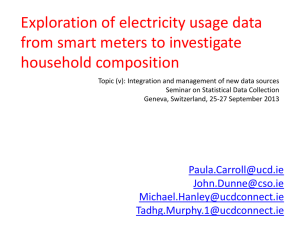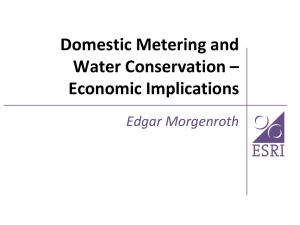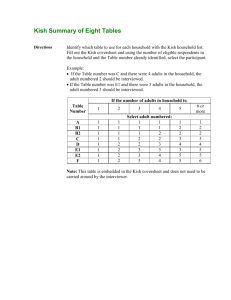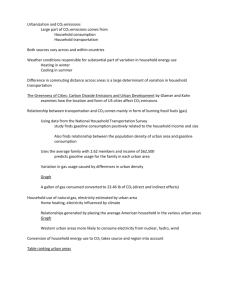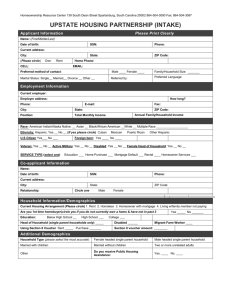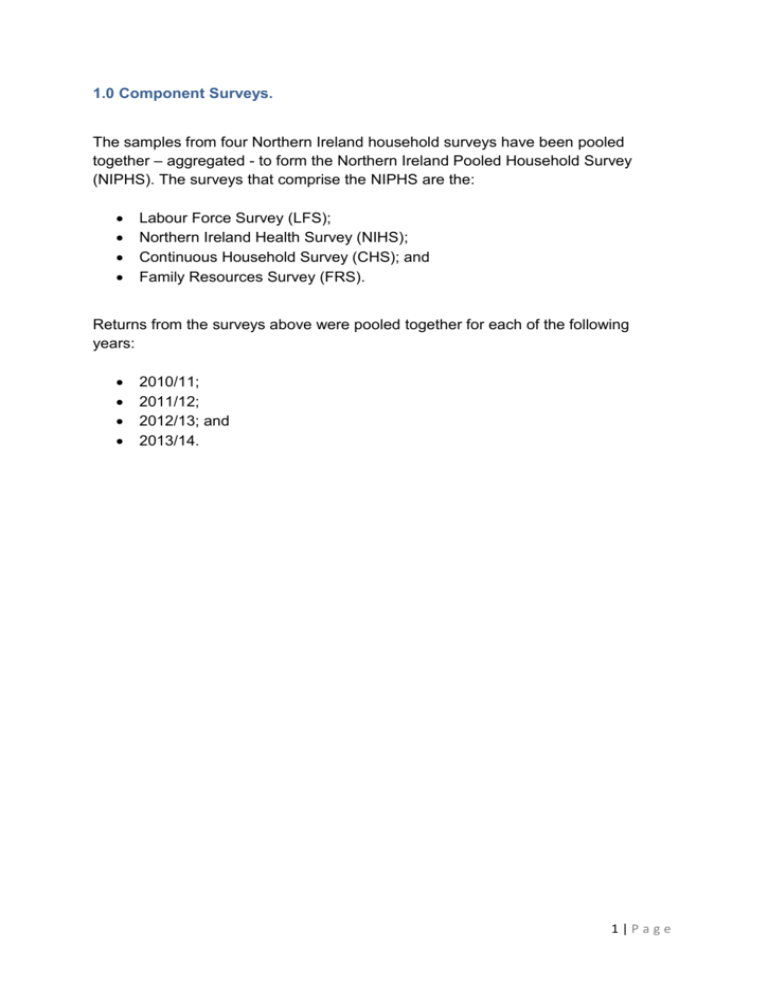
1.0 Component Surveys.
The samples from four Northern Ireland household surveys have been pooled
together – aggregated - to form the Northern Ireland Pooled Household Survey
(NIPHS). The surveys that comprise the NIPHS are the:
Labour Force Survey (LFS);
Northern Ireland Health Survey (NIHS);
Continuous Household Survey (CHS); and
Family Resources Survey (FRS).
Returns from the surveys above were pooled together for each of the following
years:
2010/11;
2011/12;
2012/13; and
2013/14.
1|Page
2.0 Sample Size
Responses on the core questions from the component surveys have been pooled to
provide a dataset with a sample size of 10,000 households and 20,000 adults (aged
16+) per annum. Data for the four financial years are shown in the table below.
Household and Individual Responses by Year
2010/11 2011/12
Responding
Households
10,400
10,700
Adults (16+)
20,100
20,500
Children (0-15)
5,800
5,900
Responding
Population
25,900
26,400
2012/13
2013/14
Total
10,700
20,400
5,900
10,800
20,500
5,700
42,600
81,500
23,300
26,300
26,200
104,800
2|Page
3.0 Survey Design
The Northern Ireland Pooled Household Survey dataset is constructed from four
surveys which all utilise the same sample design and have the same finite target
population, both with respect to the ‘target groups’ and the reference time-period.
Households were selected into the sample for each survey from the Land and
Property Services Pointer dataset1.
All four surveys in the Northern Ireland Pooled Household Survey use unclustered
systematic random samples with equal probabilities of selection, meaning that the
design effects can be assumed equal and no adjustments to estimates of standard
errors etc. are required due to differing design effects across the component
surveys.
1
Pointer is the address database for Northern Ireland and is maintained by Land & Property Services
(LPS), with input from local councils and the Royal Mail. It is the common standard address for every
property in Northern Ireland. More information on Pointer is available at
http://www.nidirect.gov.uk/index/information-and-services/property-and-housing/your-neighbourhoodroads-and-streets/ordnance-survey-of-northern-ireland/product-range/digital-products/pointer.htm
3|Page
4.0 Survey Weighting
A sample should reflect the population it comes from and be representative with
respect to variables measured in a survey. In order to accomplish this survey
responses were weighted to pre-determined population totals. Survey weights are
associated with the respondents. Weights are used to make the estimated statistics
based on the gathered data more representative of the population from which the
data are sourced.
For the Northern Ireland Pooled Household Survey weighting up was to known
population totals by age and sex using the Northern Ireland mid –year estimates of
population produced by NISRA2 and then removing the population living in
communal establishments. Communal establishments are not sampled in the
component surveys of the Northern Ireland Pooled Household Survey and therefore
population totals need adjusted to reflect this. The annual pooled sample datafile
has around 20,000 adults in around 10,000 households. This leads to a basic
estimate of the weight per adult (and household) of around 70.
However weights were constructed at both individual and household levels using a
more refined method. Weights used population control totals of Local Government
district populations by age-band by sex. For example:
Male population aged 25-34 years living in the Lisburn and Castleragh local
government district.
The final weights produced exhibit an acceptable level of variation as shown in the
table below:
Summary Statistics: Survey Weight.
Coefficient of
year
mean
weight
minimum
weight
maximum
weight
11-12
68.2
49.5
106.7
14.02%
12-13
71.3
50.4
102.2
12.69%
13-14
71.1
51.7
129.4
14.64%
Variation, weights
2
NISRA Mid-year population estimates available at
http://www.nisra.gov.uk/demography/default.asp17.htm
4|Page
5.0 Imputation.
The Northern Ireland Pooled Household Survey requires methods to be applied to
correct for missing question responses; response imputation being such a method.
Item imputation, was carried out when some data for an individual was missing, for
example when an individual’s response relating to the qualifications he / she held
was missing due to a refusal to answer the question.
To address question or item level non-response a two-fold approach to imputation
was used; within household imputation and “Hotdecking”. Household imputation, as
the name suggests, involved replacing missing data for a household member with
corresponding responses from another household member. “Hotdeck” imputation
involves constructing imputation classes using attribute data and randomly selecting
a donor within an imputation class. Imputation classes were defined by five-year
age-bands, sex, and whether an individual was living in an owner-occupier
household or not.
For religion and ethnicity, missing values were taken from a random member of the
same household where those values existed. For education, another case from
across the full data pool sample with the same age and sex was used as a donor
case – this donor was selected on a random basis. For employment cases from the
Labour Force Survey were used as donor cases by single year of age and sex.
The Northern Ireland Pooled Household Survey contains a relatively modest amount of
item non-response; approximately 16 per cent of the file contains cases where age,
sex and household-level variables are present but the key outcome variable labour
market outcome (ILODEFR) was not.
A detailed report on weighting and imputation prepared under the Quality
Improvement Fund initiative may be accessed here.
5|Page
6.0 Errors in Estimates Derived from the Northern Ireland Household Pooled
Sample.
Errors may occur at any stage during the collection and processing of survey data.
There are two main sources of survey error:
1.
Sampling error (errors associated directly with the sample design and
estimation methods used) and;
2.
Non-sampling error (a blanket term used to cover all other errors).
Sampling error is associated with the sample design and estimation methods used.
In estimating a statistic, for example the unemployment rate, a level of error is to be
expected as the data is collected from a sample of the target population rather than
the population as a whole.
It is possible to control sampling error through the use of high quality sampling
methods and to estimate its effect using information from the sample design and
sample size. All four surveys in the NIHPS use unclustered systematic random
samples with equal probabilities of selection. In such a sample design the calculation
of a confidence interval is straightforward using the basic equation below:
+/-1.96*√(p*q/n)
Where: p=proportion in question for example the unemployment rate; q=(1-p) and
n=relevant sample size. The use of this basic equation is employed for ease of use.
The basic equation does not take account of issues such as:
Dependency of respondents answers within households;
Geographical stratification of the sample; and
Item Imputation.
Each of the above points has a differing impact on the standard error of estimates
from the NIPHS. The technically correct method of calculating standard errors would
be to use re-sampling techniques. Such methods were tested and proved to provide
very similar estimates of sampling error to the basic equation above.
6|Page
The measure of uncertainty used in the NIPHS is the Coefficient of Variation (CV).
The CV measures the variability of the estimates by expressing the standard error as
a percentage of the parameter estimate. As the coefficient of variation is not
measured in any specific unit, it facilitates comparison between surveys measuring
different underlying variables. A larger coefficient of variation implies a larger
variability. The data in the NIHPS survey tables are colour coded based on
While the sampling error may be calculated as shown previously estimates of nonsampling error are not readily available. However in delivering the four surveys
NISRA Central Survey Unit undertake several methods to minimise such errors. For
example by intensive interviewer training and the provision of guidance materials for
interviewers. CSU also employ Computer Assisted Personnel Interviewing (CAPI) as
the primary response mode. CAPI ameliorates errors in data entry and ensures as
far as possible the data is of a high quality for example by employing electronic data
checks.
7|Page
7.0 Data Release Protocols.
In order to ensure as far as possible the confidentiality of responses to the surveys
and also to ensure inferences are not made regarding unsafe data a general release
rule is employed in the Northern Ireland Pooled Household Survey regarding data
release for population related outputs. This rule is set out below
(i)
Any output with a weighted population/households of than 1,000
persons/households or more should be released (this will typically have a
sample population of at least 15); or
(ii)
Any weighted population/household which is less 1,000
persons/households could be released but only if the raw sample
population/household count is greater than or equal to 10
persons/households.
These rules safeguard confidentiality and provide robust statistics. In overall sample
terms outputs will have a Coefficient of Variation of at worst 30% (see below).
Sample N
Threshold
p
q
Standard error of the estimate
Coefficient of Variation
20,000
10
0.05%
99.95%
0.016%
32%
8|Page


